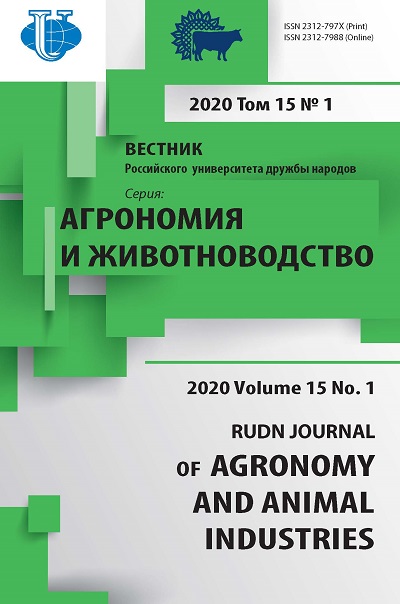Oat talgan as a source of antioxidants
- Authors: Sumina A.V.1, Polonsky V.I.2,3, Shaldaeva T.M.4, Shulbaeva M.T.5
-
Affiliations:
- Krasnoyarsk State Agrarian University
- Katanov Khakass State University
- Siberian Federal University
- Central Siberian Botanical Garden
- Kemerovo State University
- Issue: Vol 15, No 1 (2020)
- Pages: 19-29
- Section: Crop production
- URL: https://agrojournal.rudn.ru/agronomy/article/view/19540
- DOI: https://doi.org/10.22363/2312-797X-2020-15-1-19-29
- ID: 19540
Cite item
Full Text
Abstract
The purpose of the study was to analyze the total content of antioxidants (TAC) in the national Khakass product talgan consisted of oats grain. Talgan was prepared according to traditional (frying, grinding) and innovative (grinding, frying) methods. In this series of experiments, three oat cultivars were used: Argument (chaffy caryopsis), Tubinsky (chaffy caryopsis) and Golets (bare-grained). All samples were grown on the territory of the Beysk state section of the Republic of Khakassia, which was characterized by favorable climatic conditions for growing grain with a high antioxidant content. For TAC determination in grain, 2 solvents were used - bidistilled water and 70% ethanol. The TAC measurement was performed on ‘Tsvet Yauza-01-AA’. Gallic acid was used as a reference sample. In oat talgan, prepared according to the traditional method from chaffy caryopsis samples, the total content of antioxidants had a higher value than that before processing (regardless of the nature of eluting solvent). However, the opposite tendency was observed in the case of bare-grained sample. Higher rates among all samples were recorded when using hot bidistilled water as eluting solvent. The use of innovative method for production of talgan showed that the total content of antioxidants in all samples had higher values in comparison with the traditional method. Using a three-factor analysis, it was found that the TAC values in oat talgan were two-thirds dependent on the method of preparing the product; solvent nature and genotype affected much less.
About the authors
Alena Vladimirovna Sumina
Krasnoyarsk State Agrarian University
Author for correspondence.
Email: alenasumina@list.ru
Candidate of Agricultural Sciences, Associate Professor, Assistant Professor, Department of Chemistry and Geoecology
Krasnoyarsk, Russian FederationVadim Igorevich Polonsky
Katanov Khakass State University; Siberian Federal University
Email: vadim.polonskiy@mail.ru
Doctor of Biological Sciences, Professor, Department of Botany and Plant Protection
Abakan, Russian FederationTatyana Mikhailovna Shaldaeva
Central Siberian Botanical Garden
Email: tanja.shaldaeva@yandex.ru
Candidate of Biological Sciences
Novosibirsk, Russian FederationMargarita Terentyevna Shulbaeva
Kemerovo State University
Email: sh-m-t@yandex.ru
Candidate of Technical Sciences, Associate Professor, Department of Technological Design of Food Production
Kemerovo, Russian FederationReferences
- Moure A, Cruz JM, Franco D., Domı́nguez JM, Sineiro J, Domı́nguez H, et al. Natural antioxidants from residual. Food Chemistry. 2001; 72(2):145–171. doi: 10.1016/S0308–8146(00)00223–5doi.org/10.1016/ S0308–8146(00)00223–5
- Tufan AN, Çelik SE, Özyürek M, Güçlü K, Apak R. Direct measurement of total antioxidant capacity of cereals: QUENCHER-CUPRAC method. Talanta. 2013; 108(4):136–142. doi: 10.1016/j.talanta.2013.02.061.
- Adom KK, Liu RH. Antioxidant Activity of Grains. Journal of Agricultural and Food Chemistry. 2002; 50(21):6182–6187. doi: 10.1021/jf0205099
- Liu RH. Whole grain phytochemicals and health. Journal of Cereal Science. 2007; 46(3):207–219. doi: 10.1016/j.jcs.2007.06.010
- Neacsu M, McMonagle J, Fletcher RJ, Scobbie L, Duncan GJ, Cantlay L, et al. Bound phytophenols from ready-to-eat cereals: Comparison with other plant-based foods. Food Chemistry. 2013; 141(3):2880–2886. doi: 10.1016/j.foodchem.2013.05.023
- Ryan L, Thondre PS, Henry CJK. Oat-based breakfast cereals are a rich source of polyphenols and high in antioxidant potential. Journal of Food Composition and Analysis. 2011; 24(7):929–934. doi: 10.1016/j. jfca.2011.02.002
- Das AK, Singh V. Antioxidative free and bound phenolic constituents in pericarp, germ and endosperm of Indian dent (Zea mays var. indentata) and flint (Zea mays var. indurata) maize. Journal of Functional Foods. 2015; 13(2):363–374. doi: 10.1016/j.jff.2015.01.012
- Aprodu I, Banu I. Antioxidant properties of wheat mill streams. Journal of Cereal Science. 2012; 56(2):189–195. doi: 10.1016/j.jcs.2012.05.005
- Patel S. Cereal bran fortified-functional foods for obesity and diabetes management: Triumphs, hurdles and possibilities. Journal of Functional Foods. 2015; 14:255–269. doi: 10.1016/j.jff.2015.02.010
- Menga V, Fares C, Troccoli A, Cattivelli L, Baiano A. Effects of genotype, location and baking on the phenolic content and some antioxidant properties of cereal species. International Journal of Food Science and Technology. 2010; 45(1):7–16. doi: 10.1111/j.1365–2621.2009.02072.x
- Borodulin DM, Shulbaeva MT, Musina ON, Shepieva BM. Innovative technology of talgan producing as a component of functional food products, taking into account national traditions of nutrition. Food processing: techniques and technology. 2017; (3):15–22. (In Russ).
- Fedina PA, Yashin AY, Chernousova NI. Determination of antioxidants in plant products by amperometric method. Chemistry of plant raw material. 2010; (2):91–97. (In Russ).
- Polonsky VI, Sumina AV, Shaldaeva TM. The content of antioxidants in Siberian grain varieties of oats grown in various conditions. Bulletin of KSAU. 2018; (1):18–24. (In Russ).
- Akimova OI, Akimov DN. The use of statistical methods for processing of experimental data when performing student papers. Vestnik KhGU. 2016;(18):76–78. (In Russ).
Supplementary files















